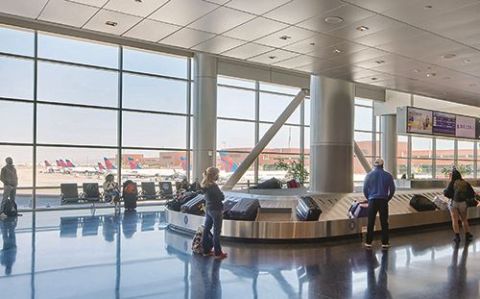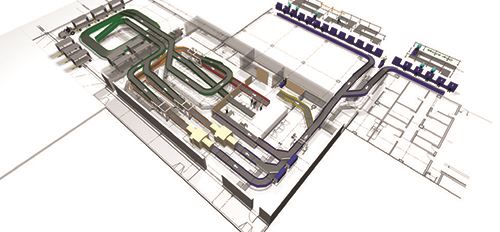Rapidly Growing Volume of Oversized Baggage Prompts System Redesign at Salt Lake City Int’l

Snowbird. Deer Valley. Park City. The natural peaks around Salt Lake City that create sought-after runs for skiers also create problematic peak days for oversized baggage at Salt Lake City International Airport (SLC). On Sundays during the busiest two and a half months of ski season, oversized bags with skis and snowboards account for fully 22% of the airport’s checked baggage—that’s seven to 10 times the average day. A high volume of long ski bags (and, in summer, golf bags and bike boxes) was expected at this popular destination for outdoor enthusiasts, but passenger growth at SLC has been significantly higher than initial projections.
When SLC’s new Concourse A opened in September 2020, its baggage handling system was designed and built to handle 12% oversized bags. But in the past three years, SLC has seen nearly twice that number, and future projections anticipate about 41% growth between now and 2027, according to Fred Viera, project manager at Introba, the company managing the baggage system redesign.
Kevin Joseph, an associate principal with Introba, says that the updated passenger numbers came to light a few years into construction. At that point, the master plan was upgraded to significantly increase the throughput requirements. “That was problematic because those initial variables are what we use to generate the design,” Joseph explains. “And if it’s not correct going in, the design is going to suffer.”
|
facts&figures Project: Baggage Handling System Upgrades Location: Salt Lake City Int’l Airport Expected Completion: 2025-2026 System Design: Introba System Mechanical: Vanderlande System Controls: Brock Solutions Key Objective: Accommodate high volume of oversize baggage by eliminating jams |
Teams from the initial project including Introba, Brock Solutions and Vanderlande Industries Inc. are diving back in with the SLC project management team to assess, analyze and model passenger and baggage numbers to devise a better solution.
Thom Lang, airline technical representative at SLC who is helping lead the initiative, says the team is laser focused on this expansion opportunity, because the current 22% of oversized bags on peak days will likely increase quickly when 25 additional gates in Concourse B are brought online in a phased manner by 2026.
Successful System in Need of a Lift
SLC is one of a handful of U.S. airports that handles oversized baggage in line with regular size bags. This dual capability is made possible by a specially designed system that includes 45-inch-wide conveyor belts and large-radius turns, explains Loggan Troncoso, automation and controls project manager with Brock Solutions.
Lang notes that this design creates a successful “one-drop shop” that allows counter agents to take both types of bags from passengers. However, the airport continues to experience challenges with bag hygiene, especially in bag crossover areas. “The straps that hang off ski and snowboard bags don’t like the bag system, especially as the oversized bags get diverted,” Lang explains. “It can create a lot of jams that really bog down the system.”
On the plus side, Viera describes the existing system as well designed and able to “soak bags up like water.” The redesign process currently underway is aimed at enhancing what is working by reducing the number of transition points and finding ways to relieve the system of oversized bags during peak periods. The addition of a seventh CTX machine to accelerate additional screening is one possible solution under consideration, he adds.
Assess, Analyze, Model, Repeat
Introba, working in tandem with Lang and the airport program management team, is analyzing the existing baggage handling system and creating models based on data such as flight schedules and airline assumptions about passenger volume, checked bags per passenger, oversized bags per passenger and what time passengers arrive at the airport. Models also take into account baggage induction points to ensure that design changes don’t allow bags to overtax the handling system from the get go.
The project team assessed data from winter and summer 2022 to create a list of issues. But with passenger numbers continuing to grow fast, it also took a detailed look at winter 2023 operations before delving too deep into a particular design concept. Specifically, personnel observed in real time what was expected to be SLC’s busiest days of the year: Sunday, February 19. That was closing day of the weekend Salt Lake City hosted the 2023 NBA All-Star game as well as a traditionally heavy travel day for skiers. Viera and his team used that information to assess throughput and develop a “baggage handling system scorecard” that measured issues with the existing design, particularly in terms of handling larger bags.

Next, the team took a more future-focused look, integrating forecasted flight schedule data for 2027 to 2050. That information is being used to dynamically model a redesigned system. “The design is different than anywhere else in the world,” Viera says. “We’re trying to manipulate and manage the ski bags a lot easier without having to change a lot of infrastructure. My job is to run those models to determine whether [the design we come up with] is going to work.”
At the same time, the team is also modeling the inbound system to assess how potential changes in operations and growth will affect SLC’s baggage claim system. That model simulates passenger and bag movements to see which is waiting longer—passengers or bags—to determine which needs more space.
The modeling system uses augmented/virtual reality technology, says Vanderlande Executive Project Manager Shane Robertson. The building information model of the baggage system design is uploaded into a virtual reality system that shows where the system clashes with mechanical, electrical, plumbing or other components that might be in the way of the baggage system.

Jonah Thompson, account manager with Vanderlande, values the unique perspective this real-time testing provides. “They’re able to observe an active system that is being used by passengers. Lots of planning goes into designing and developing these systems based off lots of data. But that’s always slightly different than how the systems in the airport are actually used by passengers.”
Fixing the Jams
Gene Lengdorfer, control systems engineer with Brock Solutions, says that the length and irregular weight distribution of oversized bags causes problems because there is no direct separation between regular and oversized bags until the final section of belt. It’s a challenge to merge bags where there is large variability in the required spacing, which relies on the ability to make dynamic adjustments. In addition, many of the conveyors need to be able to accommodate longer bags with multiple belts that stop and start together.
 Beyond the wider belts and wider turns already built into the system, Lengdorfer says the photo eyes that detect where baggage is in the system need precise placement around incline and decline belts. Merging and spacing needs will also be adjusted for longer bags.
Beyond the wider belts and wider turns already built into the system, Lengdorfer says the photo eyes that detect where baggage is in the system need precise placement around incline and decline belts. Merging and spacing needs will also be adjusted for longer bags.
Many of those tweaks, he adds, can be handled by additional programming on the PLC (programmable logic controller) side and additional layout-specific adjustments to the location of photo eyes to provide constant detection of where baggage is in the system.
One of the more significant changes in the redesign to help manage peak volume is an early bag storage system. It is already being installed and commissioned in an area of Concourse A East where make-up carousels used to reside. “The early bag storage system will give an incredible amount of upgraded operational ability to the airport,” Thompson says. “It substantially increases their ability to navigate through irregular operations, and it’s a significant upgrade to what they were planning on installing.”
Thompson adds that this update also was beneficial from a cost perspective because some of the equipment was already accounted for but not installed; so the team was able to reuse it in a different way to provide added functionality.
 “The early bag storage was a fast-track operation,” Joseph adds. “It was just about a year from the start of design until full implementation, and the airport was extremely proud of the effort that all the contractors and subcontractors did in getting that portion of it done.”
“The early bag storage was a fast-track operation,” Joseph adds. “It was just about a year from the start of design until full implementation, and the airport was extremely proud of the effort that all the contractors and subcontractors did in getting that portion of it done.”
Lengdorfer notes that layout and detection in the redesigned area will be heavily focused on accommodating oversized baggage, but will also be fully functional for normal sized baggage, helping balance baggage flow routes before and after the check baggage inspection area.
Undetermined Timeline
Lang estimates that SLC’s baggage handling system updates won’t be fully operational for another two and a half to three years. TSA felt the new design has a lot of merit to handle both current and future capacity for oversized items, but the agency blacked out the peak travel periods for making any major changes, he explains.
 While the implementation schedule, design details and budget are still in flux, keeping the current system operational in the meantime is the highest priority.
While the implementation schedule, design details and budget are still in flux, keeping the current system operational in the meantime is the highest priority.
“As with every system, we’re constantly fine-tuning it,” Lang relates. “On the control side, we’re making sure the belts are proper speeds, spacings between the bags are proper and things like that, because it will get out of tune occasionally.”
The project team is also overcoming challenges related to moving infrastructure in the ceilings and getting seismic requirements buttoned up. Vanderlande is currently putting together rough pricing and reaching out to subcontractors to visit the site for information gathering.
Committed to Working Together
Many of the players involved in the baggage system redesign have leveraged and enhanced the working relationships they developed collaborating on initial phases of the overall SLC reconstruction project. That’s been essential to keep things moving, says Thompson.

Regularly scheduled “all-hands-on-deck” meetings are structured to allow the team to quickly and efficiently navigate from design to budgeting to decision-making. “In these meetings, there is no passing the ball, no pointing fingers and no saying, ‘Well, I have to go and get with so and so,’” Thompson explains. “Everybody who needs to be a part of the decision-making process is on the call, and decisions are made quickly and efficiently.”
He estimates that this approach has compressed months of design time into weeks.
 Troncoso says the experience Introba, Vanderlande and Brock have amassed at other airports also helps facilitate decision-making—and brings out-of-box ideas to SLC’s project. Moreover, he values the insight provided from airport personnel who have been working on the baggage handling system day in and day out for the past three years. “We would normally work more with the construction group, but now we’re working with the airport operations and maintenance groups, whom we typically wouldn’t cross paths with in this kind of situation,” says Troncoso. “It’s very collaborative.”
Troncoso says the experience Introba, Vanderlande and Brock have amassed at other airports also helps facilitate decision-making—and brings out-of-box ideas to SLC’s project. Moreover, he values the insight provided from airport personnel who have been working on the baggage handling system day in and day out for the past three years. “We would normally work more with the construction group, but now we’re working with the airport operations and maintenance groups, whom we typically wouldn’t cross paths with in this kind of situation,” says Troncoso. “It’s very collaborative.”
The capability and collaboration of the project team has impressed Joseph, too. “I’ve been in baggage handling for over 25 years, and I’ve worked on a lot of different airports around the country,” he reflects. “With this project, all the players involved are very competent. They know what they want, and working with them has been a real joy. That is not always the case.”
FREE Whitepaper
PAVIX: Proven Winner for All Airport Concrete Infrastructure
International Chem-Crete Corporation (ICC) manufactures and sells PAVIX, a unique line of crystalline waterproofing products that penetrate into the surface of cured concrete to fill and seal pores and capillary voids, creating a long lasting protective zone within the concrete substrate.
Once concrete is treated, water is prevented from penetrating through this protective zone and causing associated damage, such as freeze-thaw cracking, reinforcing steel corrosion, chloride ion penetration, and ASR related cracking.
This white paper discusses how the PAVIX CCC100 technology works and its applications.








